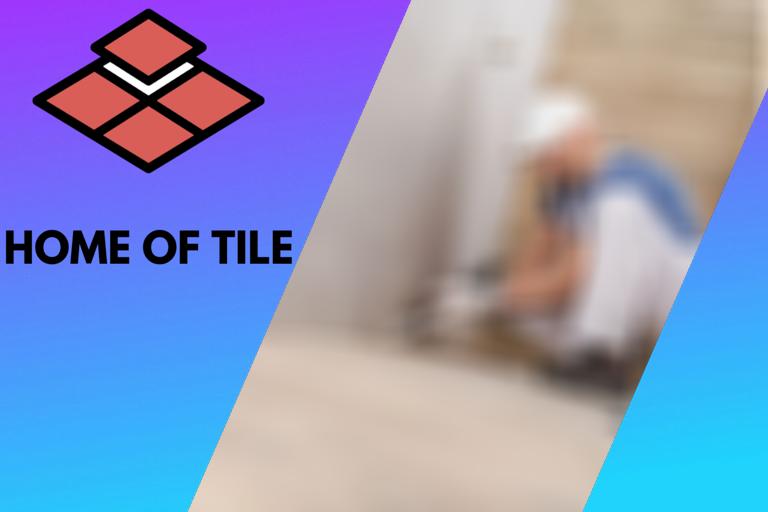Tiling and grouting, these are tips that can help you get a great result
Tiling is an excellent way to freshen up the style in your home. If you’re not afraid to do some DIY, tiling is a process that you can do yourself. You can tile your kitchen and bathroom floors and walls, as well as the hallway. This article will help with tiling and grouting and achieve great results.
Tiling and grouting, these are tips that can help you get a great result:
In general, to achieve a great result, it is important to follow a good step-by-step approach. Start with estimating the supplies you need. Check the surface you will use to lay your tiles on, particularly for wet spaces. Mark the space correctly and start from the center. Ensure that the tiles have enough time to settle before continuing. Clean the joints before grouting. Slake the grout, and towel the Haze Out. Caulk all Inside Corners, and save Some Grout for Repairs.

Contents
- 1 Tiling, what gives the best result?
- 1.1 Step 1: Calculate How Much Tiles You Need
- 1.2 Step 2: Install Waterproof Backer-board
- 1.3 Step 3: Mark Quadrants
- 1.4 Step 4: Spread Adhesive
- 1.5 Step 5: Start From the Center
- 1.6 Step 6: Wet Saw For Big Tiles
- 1.7 Step 7: Let It Dry Overnight
- 1.8 Step 8: Apply and Dry Grout For 30 Minutes
- 1.9 Step 9: Use Sealant
- 2 Grouting your floor or wall, what gives the best result?
- 2.1 ● Tools Required:
- 2.2 ● Materials Required:
- 2.3 ● How to Grout Step by Step:
- 2.3.1 Step 1: Clean the Joints
- 2.3.2 Step 2: Mix the Grout Well Until it’s Powder-Free
- 2.3.3 Step 3: Load the Grout Float
- 2.3.4 Step 4: Spread Grout and Load the Joints
- 2.3.5 Step 5: Clean Any Excess Grout
- 2.3.6 Step 6: Sponge the Surface
- 2.3.7 Step 7: Tool the Grout Lines
- 2.3.8 Step 8: Towel the Haze Out
- 2.3.9 Step 9: Caulk all Inside Corners
- 3 Sanded vs. Unsanded Grout
- 4 Grouting Floor vs. Grouting Wall
Tiling, what gives the best result?
Are you tired of the old boring floor? Tiling updates the look of your home. You can add tiles to the floors and even to the walls of your home, achieving a whole look for your space. Be it tiling a hallway floor, adding colors to your kitchen with a backsplash, or dealing with a total bathroom makeover. Tile installation can be a very easy process with proper planning and the use of the right tools. Following some simple steps, you can install tiles yourself.
Step 1: Calculate How Much Tiles You Need
It would be best if you began with estimating the supplies you need. This also gives a good indication of the time required to complete the project. To do this, determine the square footage, and measure the space carefully. Various tiles are available. Therefore, the overall square footage is important to purchase them in the correct quantity. Always get 10% more than the required number of tiles in case of damage.
Step 2: Install Waterproof Backer-board
Use a waterproof backer-board if the tile is installed in a wet space, like a bathroom or washroom. This gives an even and smooth surface for the best adhesion for tiles. Spread a very thin coat of tile adhesive or glue (consult your tile supplier as to what might work best for you) and stick it to the walls. For installing tiles on a floor, lay down a waterproof underlay (available at home improvement stores) and use it to cover the area being tiled completely.
Step 3: Mark Quadrants
Use a leveler to mark quadrants on the space you are tiling by drawing 2 lines across the center of the room, one horizontal and vertical.
Step 4: Spread Adhesive
After marking the design of your tiles (keep in mind the center and avoid making any unnecessary cuts), use a notched trowel and start spreading the adhesive on one of the marked quadrants. Starting from the center of the area, you have marked in sections of ten-square-foot. Keep spreading the adhesive until the notches are visible and it’s even. This helps the tile stick to the wall.
Step 5: Start From the Center
Start placing the tiles horizontally, at the center point of the quadrant, push the tiles into the adhesive by gently applying pressure. Using an A-Square or a leveler, make sure the tiles are being placed straight. For the best results, place tile spacers in between each tile for an even layout. Repeat these steps and work towards the outer edges of the surface.
Step 6: Wet Saw For Big Tiles
Use a snap cutter or wet saw for tiles that need to be cut smaller.
Step 7: Let It Dry Overnight
Give the tiles a full night to settle. Then use a trowel to apply grout in the spaces between the tiles, work from one corner to the opposite side of the room.
Step 8: Apply and Dry Grout For 30 Minutes
Let the grout dry for 30 minutes. Use a clean and wet sponge to clean the excess grout off the tiles.
Step 9: Use Sealant
Use tile sealant to prevent the staining of grout or it from becoming subject to moisture.
Grouting your floor or wall, what gives the best result?
Grout is a material used to fill the spaces between the tiles that are left after the installation. Grout is mostly a mixture of water, cement, color pigments, and sometimes sand.
Following are some tips given by professionals for a neat and durable tile installation.
● Tools Required:
Tile grouting requires specific tools, which are listed below.
- Bucket
- Seal gun
- Tiling sponge
- Shop vacuum
- Putty knife
- Grout float
- Microfiber towel
- Margin trowel
- Utility knife
● Materials Required:
Certain materials are also needed for the best grouting job. These materials are as follows.
- Grout (obviously)
- Caulk
- Masking tape
● How to Grout Step by Step:
Grouting is the process after you have installed tiles. The steps to grouting tiles perfectly are given below.
Step 1: Clean the Joints
Start by vacuuming the lines where grout will be placed for the debris, remodeling dust, and any chips of dried thin-set. Use a sturdy-edged putty knife to scrape any excess grout, and vacuum again. Avoid putting too much pressure while you scrape, as you may end up chipping the finishing of the tile.
– Tip: Tape the Walls Before You Grout:
To make the cleaning process easy, make sure you tape painted walls, protecting them from grout. Don’t forget to tape the trim or inset tiles that have imprinted patterns with gaps.
Step 2: Mix the Grout Well Until it’s Powder-Free
Take a mixing bucket and pour some grout out of the bag. Keep adding water from time to time and use your hands and a margin trowel to mix. Roll the bucket in a cement mixer by tilting it towards you. Do not leave any unmixed, dry grout at the bottom of the bucket. Keep scraping it with your margin trowel. Mix until all the powder is absorbed and the consistency is like peanut butter. Drip in some water using a sponge once you think you’re getting close. Do not, at any cost, use a drill or a mixing paddle to mix the grout. It introduces air into the mix and churns the grout. This produces a discoloration called “shading,” and it also weakens the cured strength. “Besides, we’re trying to mix grout here, not make soufflé.”
– Slake the Grout
When the grout is of peanut butter consistency, stop! Leave the grout alone to slake (rest) for about 10 minutes. Slaking the grout lets the chemicals do their magic. Please do not skip this step as it may result in crack-prone, weaker joints. After this, the grout might feel stiffer. This does not mean you have to add more water. Remix the grout by hand to loosen it up.
Step 3: Load the Grout Float
To start grouting, you need to take some grout out of the bucket by tilting it towards you “up the slope.” You will have a good “working batch” closer to you as this makes it easier for you to scrape up a decent amount of grout onto your float. Keep the float as tight to the side of the bucket as you can and scrape off a dollop of grout. By doing this, you can avoid any extra grout falling on the floor as it will go back to the bucket. Scoop this grout on the float. You’re now ready to grout.
Step 4: Spread Grout and Load the Joints
Diagonally spread the grout across the surface, focusing between each tile to force it deeper into the joints. It stops the grout from being scraped back onto the float. It’s suggested to grout walls before floors. This will help you prevent any mess that could be created on the floor if you grout the walls first. On vertical surfaces, such as walls, apply grout upward. This way, you won’t create much mess on the floor.
Step 5: Clean Any Excess Grout
Use a sponge in a circular motion to wipe any bulk of the grout. Doing this will help you evenly spread the grout and prevent the edge of grout float from digging into grout lines. Once all of the joints are filled, do your first “clean up” duty with the float. In this step, your main target is to remove as much excess grout off the tile surface as possible. Position the float at an angle as sharp as possible that helps you scrape excess grout from the surface.
Step 6: Sponge the Surface
As the grout starts hardening (20 to 30 minutes), begin sponging. Use a “hydrophilic” sponge that is a water-loving sponge, do not opt for just any sponge, especially not the ones from your kitchen. You get hydrophilic sponges from where you bought your tiles. Avoid using a wet sponge, dampen it and sweep diagonally across the tile’s surface to wipe any excess grout. At first, when you start doing this, you might see the grout being smeared all over the tiles—this is normal, don’t panic! Just keep repeating this process while frequently rinsing the sponge in a bucket with clean water (NEVER DO IT IN A SINK!). Continue this process until all the excess grout is cleaned.
Step 7: Tool the Grout Lines
After cleaning the surface, start tooling (smoothing and leveling) the grout lines using a sponge. Hold a sponge in your palm and gently press using your index finger to smooth out any uneven or high grout lines. Don’t apply too much pressure. It would be best if you gave all the grout joints the same shape and depth.
Step 8: Towel the Haze Out
After finishing all the joints, leave the tiles for about a half-hour. That way, the surface is dried out, and a haze is formed. Then wipe the haze away using a microfiber towel. Microfiber towels contain more fibers than cotton towels, which helps remove grout haze more effectively, achieving a more excellent finish.
– Tip: Save Some Grout for Repairs
It’s best to save a small amount of unused grout for any future touch-up. Grout over time absorbs ambient humidity, so make sure you store it in an airtight container, such as a plastic bag that can be resealed or a canning jar.
Step 9: Caulk all Inside Corners
Avoid grouting the inside corners. A grouting caulk is best for the inside corners after you’ve grouted and cleaned. Avoid overfilling the void; it’ll just make it harder to clean and tool. If your grout inside corners, it will crack over time. Make sure to use a caulk color that matches the grout you’ve used.
Sanded vs. Unsanded Grout
Sanded grout tends to be much stronger than unsanded grout, as the sand helps to resist shrinkage and cracking. It’s suggested that if the joint is larger than 1/8 inch, sanded grout should be used. Soft stone tiles, such as marble or polished limestone, can only be grouted using unsanded grout, or it might scratch the surface.
Grouting Floor vs. Grouting Wall
Grouting is an easy process that can be done on any vertical or horizontal surface. The main difference when grouting floor is that floors require sanded grout, as the joints are larger, and the sand helps reduce shrinkage and cracking. While walls require unsanded grout, except when the joints are wider than 1/8 inch. Therefore, sanded grout can be used for walls with wider joints, and unsanded grout can be used on floors with smaller joints.







